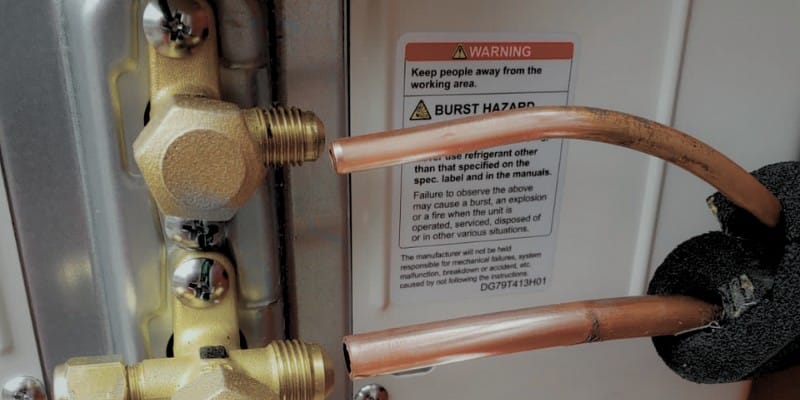Air conditioning systems have become almost as fundamental as running water or electricity. From sweltering summer days to some chilly winter nights, our AC units provide much-needed comfort. A crucial yet often overlooked component of these systems is the copper line. But what happens when this line is compromised? In this guide, we’ll delve deep into how to repair a hole in a copper AC line.
The copper AC line, commonly called the refrigerant line, acts as a conduit carrying refrigerant between the indoor and outdoor units.

The reason behind using copper is its excellent thermal conductivity, ensuring efficient heat transfer, and natural corrosion resistance. Additionally, copper possesses a unique ability to form tight connections, reducing the risk of leaks when installed correctly.
Potential Dangers of a Hole in the Copper AC Line
A hole or any damage to the copper line isn’t just an operational setback; it has broader implications:
- Loss of Refrigerant: This affects the efficiency of your AC system and is a potential environmental hazard. Certain refrigerants, when released, can contribute to greenhouse gases.
- Decreased Efficiency: A compromised line can lead to decreased efficiency. You might find your AC working twice as hard, consuming more power, yet failing to cool or heat your space adequately.
- Moisture Infiltration: A hole can allow moisture to seep in. When mixed with certain refrigerants, this moisture can form a corrosive acid, damaging your AC from the inside out.
Tools & Materials Needed for Repair
Before embarking on the repair process, gather all necessary tools and materials. Prioritize safety. Remember, you’ll be dealing with potentially harmful refrigerants and a soldering torch.
- Safety Gear: Always use safety goggles to protect your eyes and gloves to guard your hands from burns or cuts.
- Soldering Torch: Essential for sealing the copper patch or coupling.
- Flux & Lead-Free Solder: A binding agent ensures a secure connection.
- Copper Repair Coupling or Patch: Depending on the hole size, you’d either patch it or replace a section of the line using a coupling.
- Sandpaper or Steel Wool: For cleaning and prepping the damaged area.
- Pipe Cutter: A pipe cutter will be essential to replace a line section.
Step-by-Step Guide to Repairing a Hole in a Copper AC Line
One # Turn Off and Depressurize the System
Your first step is to turn off the AC system. Ensure it’s entirely depressurized, eliminating any risk of refrigerant escaping during the repair.
Two # Clean the Damaged Area
Use your sandpaper or steel wool to scrub around the hole gently. This isn’t just about cleaning; it’s about creating a rough surface, which allows for better adhesion during the patching process.
Three # Patch or Couple Based on Hole Size
For smaller holes, applying flux and then solder might suffice. But larger holes or more significant damage require a more extensive repair. Use the pipe cutter to remove the damaged section and replace it with a copper coupling.
Four # Test for Leaks
Once the repair is done, turn your system back on. Listen for any hissing sounds or check for visible signs of leaks. Ensuring a tight seal is paramount for the efficiency and longevity of your AC system.
DIY vs. Professional Repair
While some homeowners might consider tackling minor AC reapair as a DIY project, saving on labor costs, there are risks involved:
- Incorrect Repairs: If not properly fixed, the system might still leak refrigerant, or moisture might enter, causing more significant problems.
- Safety Concerns: Working with refrigerants requires expertise and appropriate tools. Incorrect handling can be hazardous.
- Voiding Warranty: DIY repairs might void the manufacturer’s warranty on the AC unit.
DIY repairs are cost-effective and can be rewarding. However, remember that AC systems are intricate machines. While small holes can often be patched up at home, professionals should address more extensive damage, especially in systems that incorporate modern refrigerants or advanced features. Professional HVAC technicians bring expertise and have the equipment to test for leaks, ensuring the repair’s longevity.
How Much Does It Cost to Fix a Copper AC Line?
Average cost breakdown:
- Service Call Fee: Most HVAC professionals charge a service call fee ranging from $50 to $150. This fee covers the technician’s time and expertise in diagnosing the problem.
- Labor Costs: Depending on the abovementioned factors, labor costs can range from $50 to $150 per hour. Expect a technician to spend 1-3 hours on most copper line repairs.
- Materials: A replacement copper pipe can cost anywhere from $10 to $30 per foot, depending on the diameter and type of copper. Add the cost of soldering materials, flux, and other supplies.
- Refrigerant Recharge: Depending on your AC’s refrigerant type (like R-22 or R-410A), a recharge can cost anywhere from $50 to $200 or more.
Combining all these factors, a straightforward repair for a small leak where minimal refrigerant has been lost can cost as low as $200 to $400. However, more extensive repairs requiring several feet of replacement copper or dealing with hard-to-access areas can push costs upwards of $500 to $1,000 or more.
Maintenance Tips to Prevent Future Damage
Regular maintenance can often preempt many issues before they become more significant.
- Regular System Checks: Inspect your copper lines at least once a season. Check for signs of corrosion, wear, or potential damage.
- Proper Insulation: Insulating your copper lines protects them from external damage and ensures they function optimally, regardless of the weather conditions outside.
- Address Issues Promptly: Found a tiny crack or pinhole leak? Address it immediately. Delays can escalate the issue, leading to costlier repairs down the line.
Repairing a copper AC line can vary in cost depending on the nature of the damage and other influencing factors. While it is tempting to patch a minor issue yourself, considering the technical aspects of the repair and potential pitfalls, consulting or hiring a professional is the best course of action. As with all home repairs, obtaining multiple quotes and ensuring you’re working with licensed professionals can help ensure quality work at a fair price.






